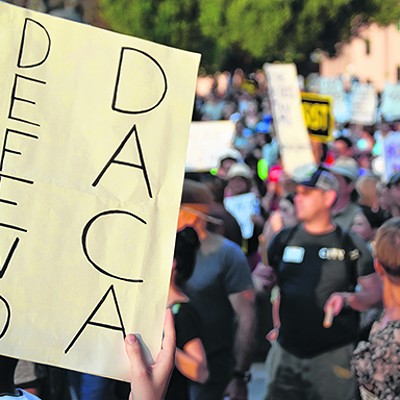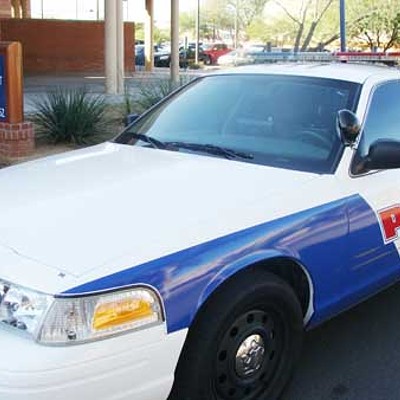The fact that some people are surprised when they get stopped by a UA Police Department patrol car amazes Sgt. Juan Alvarez.
"It's as if they think we're some type of campus security," quipped Alvarez, the UAPD public-information specialist who has been with the force for more than 20 years.
The UAPD patrol area reaches into surrounding neighborhoods in what's called the UA "planning boundary." That boundary and a long-standing agreement with the Tucson Police Department allow UAPD officers to monitor high-traffic streets, such as Speedway Boulevard and Campbell and Euclid avenues.
And when asked if UAPD traffic-patrol cars sit off streets like Campbell to check for speeders, Alvarez said yes.
"It is very common for us to patrol in the area of the planning boundary," he explained. "A lot of traffic goes through this area that is also coming to the campus. That's why we're there."
According to a public-records request filed by the Weekly, the UAPD issued 3,929 traffic citations for 5,630 offenses in 2008. Through Oct. 29, the department has issued 3,055 traffic citations for 4,434 offenses this year.
Alvarez said that if you consider the fact that each UAPD traffic-patrol officer makes an average six to 12 stops a day, the numbers make sense.
"There's no goal issue or quota," Alvarez said. "We're dealing with a population on campus of more than 55,000 people every day, and we're in the middle of the city. Our main focus (when we issue citations) is to educate the public on traffic law."
The UAPD normally has five traffic-patrol officers. Regular patrol officers also make traffic stops; the UAPD has three patrol teams with eight officers each. There are also three investigative detectives on staff as well.
The majority of the citations are issued in the outlying areas within the planning boundary. The planning boundary includes the main campus, as well as other school buildings on outlying streets. The boundary area goes south to 8th Street, north to Lester Street, west to Euclid Avenue and east to Campbell Avenue. Alvarez said the UAPD also patrols Mount Graham, where the UA operates an astronomy facility, with four officers who live on the premises.
Though UAPD officers write almost 4,000 citations a year, that doesn't mean the UAPD is making lots of money for its work; Alvarez said all the ticket fees go to the Pima County Justice Court.
"Maybe some of the money from the fines comes back through the state, but I don't really know," Alvarez explained.
According to Ralph Garcia Jr., the Pima County Justice Court's case-management supervisor, UAPD-issued tickets are treated just like tickets issued by the Pima County Sheriff's Department. Ten dollars goes to the Justice Court Enhancement Fund, and the remaining amount goes to other state and county funds, such as Clean Elections and the Fill the Gap fund that collects money for the Pima County Attorney's Office and the Pima County Public Defender's Office.
Alvarez said there are also areas of Tucson where the Tucson Police Department has explicitly asked the UAPD to help out, due to stressed TPD resources. Once spot is the gas station on the northwest corner of Park Avenue and Sixth Street.
"If they get called out there, they'll ask us to respond. We're closer and often have the resources available," Alvarez said.
The FBI has laid down some ground rules on what cases the UAPD should respond to within the planning boundary. Crimes such as kidnapping, assault, forgery and DUI are assigned on a case-by-case basis. The UAPD, as the main enforcement agency with jurisdiction, handles crimes such as murder, burglary, sexual assault, car theft and arson within the planning boundary, Alvarez said.
One example is the murder of UA student Mia Henderson by her roommate Galareka Harrison in the Graham-Greenlee Residence Hall on Sept. 5, 2007. (Harrison was sentenced to life without parole.) Alvarez said the UAPD handled the crime scene and the investigation that followed, although it did request forensic assistance by the state Department of Public Safety, since the UAPD does not have a forensics department.
While murder is on the list of crimes that the UAPD will handle, the agency will not respond to possible red tags at student parties off-campus—even if they're within the UA planning boundary. Alvarez said those are left up to Tucson police.
Despite the list of who does what or who responds to what, Alvarez said all law-enforcement agencies are equal in terms of training and how they are held accountable.
In a conference room at the UAPD headquarters at First Street and Campbell Avenue, Alvarez pointed to a framed accreditation certificate from a national organization that audits law-enforcement agencies across the country.
Every three years, the UAPD goes through an audit from the Commission on Accreditation for Law Enforcement Agencies (CALEA), which looks at police-department records, arrests, the handling of evidence and pretty much everything else any law-enforcement agency does to operate.
"Last March, we received our sixth accreditation," Alvarez said, adding it's the same accreditation that the Tucson Police Department receives, through the same audit process.
Alvarez said the UAPD's authority as peace officers—and the authority of other Arizona state university police departments—comes from the Arizona Board of Regents. Every officer and detective is also considered a commissioned officer of the state.
"We can respond to a traffic violation in Oro Valley if we are there," Alvarez said, adding that his officers are not making routine trips to Oro Valley.
"But because we are commissioned officers, we are able to respond even outside the UA (planning) boundary."
And the training is the same, too. Alvarez said new UAPD hires are sent to the Tucson Police Academy to receive the same training as TPD officers.
"We're about the size of a medium-size city's police department, but we're in this interesting situation of being in the middle of Tucson. And we're doing the same things as other police departments; we just happen to be on a campus," Alvarez said.













